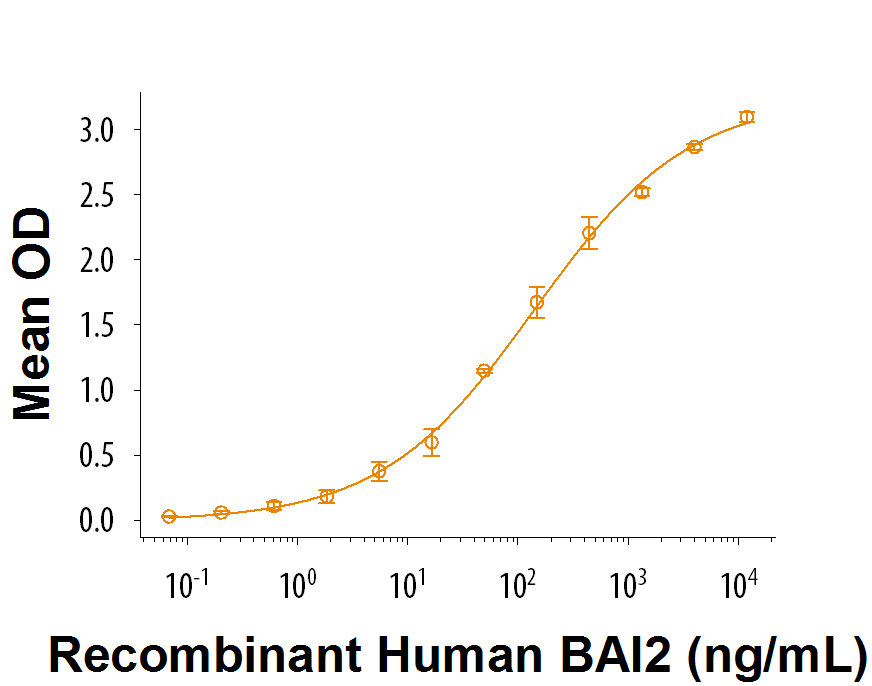Recombinant Human C1qTNF10/C1qL2 Protein, CF Summary
Product Specifications
Phe154-Asp287, with an N-terminal Met and 6-His tag
Analysis
Product Datasheets
Carrier Free
CF stands for Carrier Free (CF). We typically add Bovine Serum Albumin (BSA) as a carrier protein to our recombinant proteins. Adding a carrier protein enhances protein stability, increases shelf-life, and allows the recombinant protein to be stored at a more dilute concentration. The carrier free version does not contain BSA.
In general, we advise purchasing the recombinant protein with BSA for use in cell or tissue culture, or as an ELISA standard. In contrast, the carrier free protein is recommended for applications, in which the presence of BSA could interfere.
9189-TN
| Formulation | Lyophilized from a 0.2 μm filtered solution in Tris, NaCl, TCEP and Trehalose. |
| Reconstitution | Reconstitute at 500 μg/mL in water. |
| Shipping | The product is shipped at ambient temperature. Upon receipt, store it immediately at the temperature recommended below. |
| Stability & Storage: | Use a manual defrost freezer and avoid repeated freeze-thaw cycles.
|
Scientific Data
 View Larger
View Larger
When Recombinant Human C1qTNF10 (Catalog # 9189-TN) is coated at 2 μg/mL, 100 μL/well, Recombinant Human BAI2 Fc Chimera binds with a ED50 of 0.075-0.45 μg/mL.
Reconstitution Calculator
Background: C1qTNF10/C1qL2
C1qTNF10 (CTRP10), also known as C1qL2, is an approximately 30 kDa member of the C1q family of secreted proteins (1, 2). Mature human C1qTNF10 contains a collagen-like region and one C1q-like domain. It can form heterotrimers and higher order disulfide linked oligomers with C1qTNF1, C1qTNF11/C1qL4, and C1qTNF13/C1qL3 (3-6). Within the C1q-like domain, human C1qTNF10 shares 100% aa sequence identity with mouse and rat C1qTNF10. Similarly to C1qTNF11, C1qTNF13, and C1qTNF14/C1qL1, C1qTNF10 binds to BAI3 in the cerebral cortex and on cerebellar Purkinje cells (7). It is produced by mossy fibers in the hippocampus where it enhances the postsynaptic clustering of kainate-type glutamate receptors (KAR) on CA3 pyramidal neurons (8). This function is enhanced by the binding of C1qTNF10 to the KAR subunits GluK2 and GluK4 as well as to Neurexin-3 beta containing the exon 5b splice site insertion (8).
- Grebrehiwet, B. et al. (2012) Front. Immunol. 5:3.
- Yuzaki, M. (2001) Eur. J. Neurosci. 32:191.
- Peterson, J.M. et al. (2009) Biochem. Biophys. Res. Commun. 388:360.
- Wei, Z. et al. (2011) J. Biol. Chem. 286:15652.
- Wei, Z. et al. (2013) J. Biol. Chem. 288:10214.
- Wong, G.W. et al. (2008) Biochem. J. 416:161.
- Bolliger, M.F. et al. (2011) Proc. Natl. Acad. Sci. USA 108:2534.
- Matsuda, K. et al. (2016) Neuron 90:752.
FAQs
No product specific FAQs exist for this product, however you may
View all Proteins and Enzyme FAQsReviews for Recombinant Human C1qTNF10/C1qL2 Protein, CF
There are currently no reviews for this product. Be the first to review Recombinant Human C1qTNF10/C1qL2 Protein, CF and earn rewards!
Have you used Recombinant Human C1qTNF10/C1qL2 Protein, CF?
Submit a review and receive an Amazon gift card.
$25/€18/£15/$25CAN/¥75 Yuan/¥1250 Yen for a review with an image
$10/€7/£6/$10 CAD/¥70 Yuan/¥1110 Yen for a review without an image
